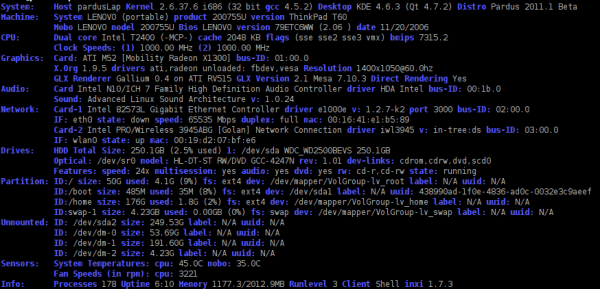Sometimes it is useful to know in detail what hardware components our computer uses. For this, we have already seen that there are graphical tools as Hardinfo although it is also possible to take a look at the system boot message or use use some terminal commandsas lsusb, lspci, etc o dmidecode.
However, yesterday I discovered a new option, which is installed by default in some popular distributions: inxi.
What is inxi?
inxi It is a very complete script that allows to display the information of the system's hardware. It is written in bash so it can be used directly from a terminal.
inxi comes pre-installed with SolusOS, crunchbang, Epidemic, Linux Mint, Anti-X y Arch Linux, but since it is a bash script it works on many other distros. While it is designed for use with chat applications such as IRCIt also works from a shell and provides a huge amount of information. It is a fork of the script infobash, very useful but has received little maintenance in recent times.
inxi it's compatible with conversation, xchat, irssi, Quassel; as well as in most of the clients of IRC.
How to install inxi
inxi It is present in the default repository of most distributions, so it is possible to install it with the following commands:
Install inxi en Arch and derivatives:
# Pacman -s Inxi
Install inxi en Debian / Ubuntu and derivatives:
# apt-get install inxi
Install inxi en Fedora and derivatives:
# Yum Install Inxi
How to use inxi
You just have to open a terminal and run the script:
inxi
It is possible to limit the information to be displayed based on the following parameters:
-A Show sound card information.
-C Show CPU information, including CPU clock speed.
-D Show hard drive information, not just the model.
-F Show full output for inxi. Includes all uppercase letters, plus -s and -n.
-G Show graphics card information (card, type, resolution, glx processor, version, etc.).
-I General information: active processes, uptime, memory, IRC client, inxi version.
-l Show partition labels.
-n Show advanced information of the network card. Same as -Nn. Shows the interface, speed, MAC address, status, etc.
N Show network card information. With -x, it shows PCI BusID, port number.
To see a complete list of available options, I suggest reading the Official Site of the project.

I gave it a try and loved the amount of information it provides along with how simple it is. Very good tip 😉
You're welcome!
Hug! Paul.
Excellent, I didn't know him. It is appreciated.
As Gentoo does not have it by default, here is my layout. Here you can find this and other packages 😀
https://github.com/jorgicio/jorgicio-gentoo
Very useful, I had it written down among my utilities .. ..I thought I had seen it here on the blog .. ee
For a complete output .. .. inxi -v7
That is what this blog has. We've written about SO MANY things that we already seem to write about everything. Likewise, we had never made a specific post about inxi. I checked before writing this post.
Hug! Paul.
Very good, and complete, the truth is that it surprises me.
The best thing is that it is easy to read, which is appreciated.
Very good!
Very good tip =)
Just one comment: I tried to install it on Kubuntu Precise, but it didn't show up in the repositories, so I solved it by adding the Linux Mint Maya repository (import specifically), which does include it and that's it.
Greetings.
Thanks for remembering it.
I had it for a long time and because I stopped using it, I forgot its name.
I love these simple programs that quickly resolve your doubts.
hey, it's a lie that it comes "pre-installed" in archlinux, if it doesn't really have anything installed, it doesn't have it in base, less in base-devel. You should correct that information please.